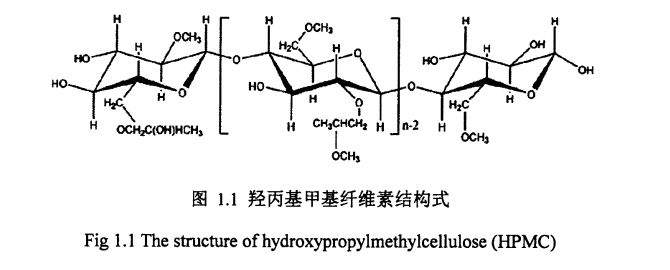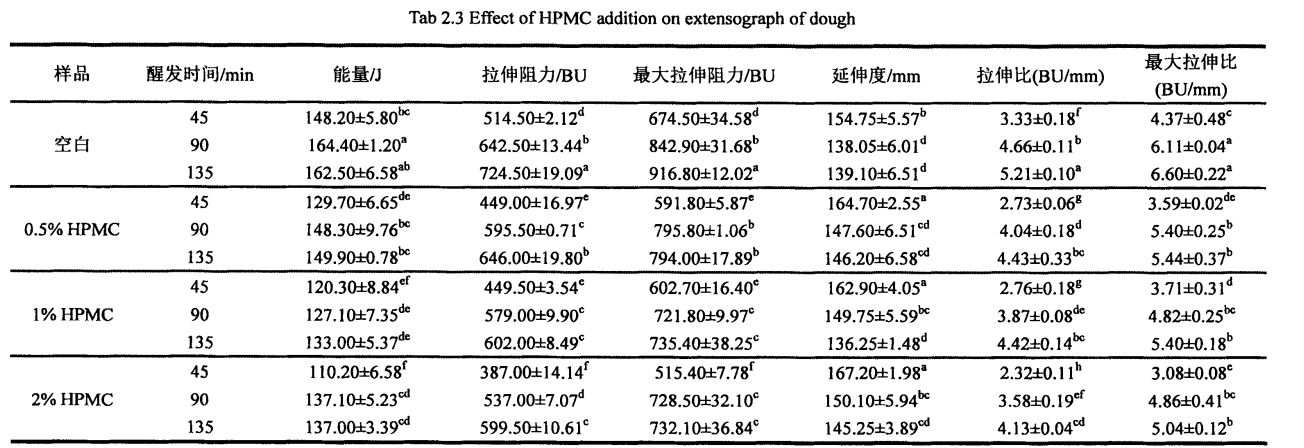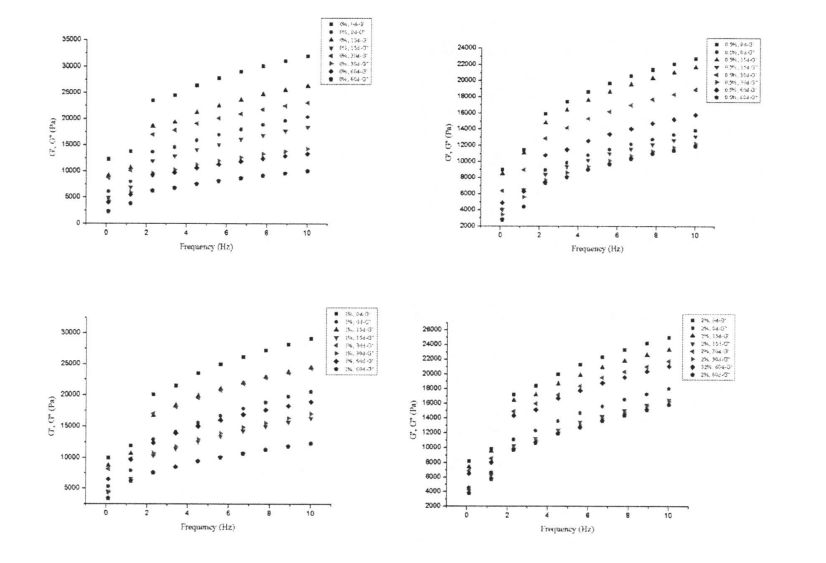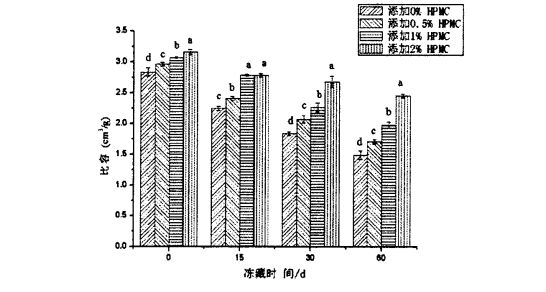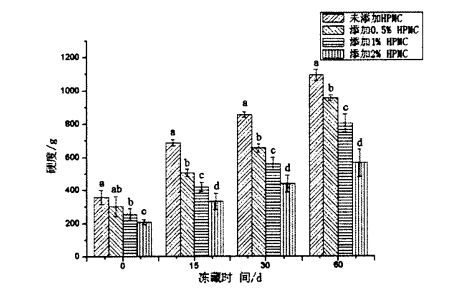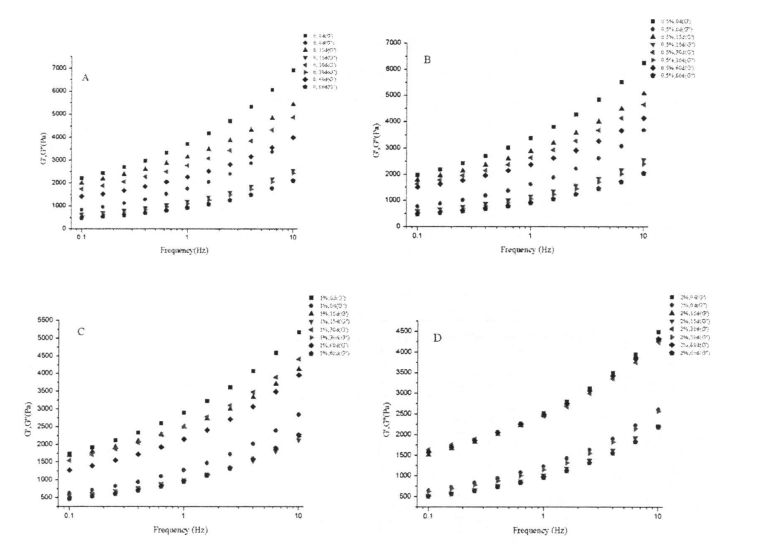Obsah
1.1.7 Hydroxypropyl methyl cellulose (Hydroxypropyl methyl cellulose, I-IPMC) ………. 5
1.3 Hlavný obsah štúdie ...................................................................................................
2.3 Experimental results and discussion…………………………………………………………………… . 11
3.2.4 Experimental methods ....................................................................................................... 25
3.3.2 The effect of adding amount of HPMC and freezing storage time on the freezable moisture content (CFW) and thermal stability……………………………………………………………………. 30
3.3.3 Effects of HPMC addition amount and freezing storage time on free sulfhydryl content (C vessel) …………………………………………………………………………………………………………. . 34
4.1 Introduction .............................................................................................................................. . 44
4.2 Experimental materials and methods ................................................................................. 45
4.3 Analysis and discussion ........................................................................................................... 48
4.3.1 Content of basic components of wheat starch ……………………………………………………. 48
4.3.3 Effects of HPMC addition and freezing storage time on the shear viscosity of starch paste………………………………………………………………………………………………………………………………………. 52
4.3.6 Effects of I-IPMC addition amount and frozen storage time on the thermodynamic properties of starch ………………………………………………………………………………………………………. . 57
Chapter 5 Effects of HPMC addition on yeast survival rate and fermentation activity under frozen storage conditions………………………………………………………………………………………………. . 62
5.1Introduction .................................................................................................................................... 62
5.2 Materials and methods ............................................................................................................ 62
5.2.2 Experimental methods . . . . . …………………………………………………………………………. 63
5.3 Results and Discussion ............................................................................................................... 64
5.3.3 The effect of adding amount of HPMC and freezing time on the content of glutathione in dough……………………………………………………………………………………………………………66. „
5.4 Chapter Summary ........................................................................................................................ 67
6.1 Conclusion ................................................................................................................................. . 68
6.2 Outlook .......................................................................................................................................... 68
Figure 1.1 The structural formula of hydroxypropyl methylcellulose………………………. . 6
Figure 2.4 The effect of HPMC addition and freezing time on the elasticity of steamed bread………………………………………………………………………………………………………………………………. . 20
Figure 3.1 The effect of HPMC addition and freezing time on the rheological properties of wet gluten…………………………………………………………………………………………………………………………. 30
Figure 3.2 Effects of HPMC addition and freezing time on the thermodynamic properties of wheat gluten………………………………………………………………………………………………………………. . 34
Figure 3.3 Effects of HPMC addition and freezing time on free sulfhydryl content of wheat gluten……………………………………………………………………………………………………………………………... . 35
Figure 3.7 The effect of HPMC addition and freezing time on the microscopic gluten network structure…………………………………………………………………………………………………………... . 43
Figure 4.1 Starch gelatinization characteristic curve ............................................................... 51
Figure 4.2 Fluid thixotropy of starch paste ................................................................................. 52
Figure 4.3 Effects of adding amount of MC and freezing time on the viscoelasticity of starch paste……………………………………………………………………………………………………………………... . 57
Figure 4.5 Effects of HPMC addition and freezing storage time on the thermodynamic properties of starch…………………………………………………………………………………………………………. . 59
Figure 5.2 The effect of HPMC addition and freezing time on the yeast survival rate…………………………………………………………………………………………………………………………………... . 67
Figure 5.3 Microscopic observation of yeast (microscopic examination) …………………………………………………………………………………………………………………………. 68
Table 2.1 The basic ingredient content of wheat flour…………………………………………………. 11
Table 3.2 Effects of I-IPMC addition amount and freezing storage time on the phase transition enthalpy (Yi IV) and freezer water content (e chat) of wet gluten………………………. 31
Table 3.3 Effects of HPMC addition amount and freezing storage time on the peak temperature (product) of thermal denaturation of wheat gluten…………………………………………. 33
Table 3.6 Effects of I-IPMC addition and freezing storage time on the surface hydrophobicity of wheat gluten……………………………………………………………………………………………. 41
Table 4.3 Effects of I-IPMC addition and freezing time on the shear viscosity of wheat starch paste…………………………………………………………………………………………………………………………. 55
1)Development of new characteristic steamed buns. Through the innovation of steamed bread raw materials and the addition of functional active substances, new varieties of steamed breads have been developed, which have both nutrition and function. Established the evaluation standard for the quality of miscellaneous grain steamed bread by principal component analysis; Fu et a1. (2015) added lemon pomace containing dietary fiber and polyphenols to steamed bread, and evaluated the antioxidant activity of steamed bread; Hao & Beta (2012) študoval jačmenné otruby a ľanové semeno (bohaté na bioaktívne látky) výrobný proces duseného chleba [5]; Shiau et a1. (2015) evaluated the effect of adding pineapple pulp fiber on dough rheological properties and steamed bread quality [6].
5)Preservation and anti-aging of steamed bread and related mechanisms. Pan Lijun et al. (2010) optimized the composite modifier with good anti-aging effect through experimental design [l do not; Wang, et a1. (2015) studied the effects of gluten protein polymerization degree, moisture, and starch recrystallization on the increase of steamed bread hardness by analyzing the physical and chemical properties of steamed bread. The results showed that water loss and starch recrystallization were the main reasons for the aging of steamed bread [20].
7) Výskum aplikácie mrazeného cesta v dusenom chlebe.
II. Optimization of frozen dough production process, frozen storage conditions and formula. During the production of frozen dough, temperature control, proofing conditions, pre-freezing treatment, freezing rate, freezing conditions, moisture content, gluten protein content, and thawing methods will all affect the processing properties of frozen dough [37]. In general, higher freezing rates produce ice crystals that are smaller in size and more uniformly distributed, while lower freezing rates produce larger ice crystals that are not uniformly distributed. In addition, a lower freezing temperature even below the glass transition temperature (CTA) can effectively maintain its quality, but the cost is higher, and the actual production and cold chain transportation temperatures are usually small. In addition, the fluctuation of the freezing temperature will cause recrystallization, which will affect the quality of the dough.
III. Using additives to improve the product quality of frozen dough. In order to improve the product quality of frozen dough, many researchers have made explorations from different perspectives, for example, improving the low temperature tolerance of material components in frozen dough, using additives to maintain the stability of the dough network structure [45.56], etc. Among them, the use of additives is an effective and widely used method. Mainly include, i) enzyme preparations, such as, transglutaminase, O [. Amylase; ii) emulsifiers, such as monoglyceride stearate, DATEM, SSL, CSL, DATEM, etc.; iii) antioxidants, ascorbic acid, etc.; iv) polysaccharide hydrocolloids, such as guar gum, yellow Originalgum, gum Arabic, konjac gum, sodium alginate, etc.; v) other functional substances, such as Xu, et a1. (2009) added Ice-structuring Proteins to wet gluten mass under freezing conditions, and studied its protective effect and mechanism on the structure and function of gluten protein [y71.
Chemická povaha hydrokoloidu je polysacharid, ktorý sa skladá z monosacharidov (glukóza, rahamnóza, arabinóza, manóza atď.) Do 0 [. 1-4. Glycosidic bond or/and a. 1--"6. Glycosidic bond or B. 1-4. Glycosidic bond and 0 [.1-3. The high molecular organic compound formed by the condensation of glycosidic bond has a rich variety and can be roughly divided into: ① Cellulose derivatives , such as methyl cellulose (MC), carboxymethyl cellulose (CMC); ② plant polysaccharides, such as konjac gum, guar gum, gum Arabic ; ③ seaweed polysaccharides, such as seaweed gum, carrageenan; ④ microbial polysaccharides, such as Xanthan gum .Polysaccharide has strong hydrophilicity because it contains a large number of hydroxyl groups that are easy to form hydrogen bonds with water, and has the functions of controlling the migration, state and distribution of water in the food system. Therefore, the addition of hydrophilic colloids gives food Many functions, properties, and qualities of hydrocolloids are closely related to the interaction between polysaccharides and water and other macromolecular substances. At the same time, due to the multiple functions of thickening, stabilizing, and water retention, hydrocolloids are widely used to include in the food processing of flour products. Wang Xin et al. (2007) studied the effect of adding seaweed polysaccharides and gelatin on the glass transition temperature of dough [631. Wang Yusheng et al. (2013) believed that compound addition of a variety of hydrophilic colloids can significantly change the flow of dough. Zmeňte vlastnosti, vylepšite pevnosť cesto v ťahu, zvýšte elasticitu cesta, ale znížte rozšíriteľnosť cesta [vymazať.
1)Select a new type of hydrophilic colloid, hydroxypropyl methylcellulose (HPMC) as an additive, and study the addition amount of HPMC under different freezing time (0, 15, 30, 60 days; the same below) conditions. (0%, 0.5%, 1%, 2%; the same below) on the rheological properties and microstructure of frozen dough, as well as on the quality of the dough product - steamed bread (including the specific volume of steamed bread) , texture), investigate the effect of adding HPMC to the frozen dough on the processing properties of the dough and the quality of steamed bread, and evaluate the improvement effect of HPMC o spracovateľských vlastnostiach mrazeného cesta;
Powder meter. E
Extensometer. E
Výrobca
Weigh a sample of about 15 mg of the central part of the fully melted dough, seal it in an aluminum crucible (suitable for liquid samples), and measure it with a Differential Scanning Calorimetry (DSC). Konkrétne parametre programu sú nastavené. As follows: first equilibrate at 20°C for 5 min, then drop to .30°C at a rate of 10"C/min, keep for 10 min, and finally rise to 25°C at a rate of 5"C/min, the purge gas is nitrogen (N2) And its flow rate was 50 mL/min. Using the blank aluminum crucible as a reference, the obtained DSC curve was analyzed using the analysis software Universal Analysis 2000, and the melting enthalpy (day) of the ice crystal was obtained by integrating the peak located at about 0°C. Freezable water content (CFW) is calculated by the following formula [85.86]:
Podľa GB/T 20981.2007 [871 sa na meranie objemu (práce) dusených buchtov použila metóda vytesnenia repky a hmotnosť (m) dusených buchty sa merala pomocou elektronickej rovnováhy. Each sample was replicated three times.
2.3.1 Základný index zloženia pšeničnej múky
J (2% HPMC added). At the same time, the maximum tensile resistance of the dough decreased from 674.50-a: 34.58 BU (blank) to 591.80--a: 5.87 BU (adding 0.5% HPMC), 602.70± 16.40 BU (1% HPMC added), and 515.40-a: 7.78 BU (2% HPMC added). Predĺženie cesta sa však zvýšilo z 154,75+7,57 MITI (prázdne) na 164,70-A: 2,55 M/RL (pridanie 0,5% HPMC), 162,90-A: 4,05 min (pridané 1% HPMC) a 1 67,20-A: 1,98 min (2% HPMC). This may be due to the increase of the plasticizer-water content by adding HPMC, which reduces the resistance to the deformation of the gluten protein molecular chain, or the interaction between HPMC and the gluten protein molecular chain changes its stretching behavior, which in turn affects It improves the tensile properties of the dough and increases the extensibility of the dough, which will affect the quality (eg, specific volume, texture) of the final product.
Nie všetka vlhkosť v cesta môže tvoriť ľadové kryštály pri určitej nízkej teplote, ktorá súvisí so stavom vlhkosti (voľný tok, obmedzený, v kombinácii s inými látkami atď.) A jej prostredím. Freezable water is the water in the dough that can undergo phase transformation to form ice crystals at low temperatures. The amount of freezable water directly affects the number, size and distribution of ice crystal formation. In addition, the freezable water content is also affected by environmental changes, such as the extension of freezing storage time, the fluctuation of freezing storage temperature, and the change of material system structure and properties. For the frozen dough without added HPMC, with the prolongation of freezing storage time, Q silicon increased significantly, from 32.48±0.32% (frozen storage for 0 days) to 39.13±0.64% (frozen storage for 0 days). Tibetan for 60 days), the increase rate was 20.47%. Po 60 dňoch mrazeného skladovania, so zvýšením pridávania HPMC, sa však zvýšila miera CFW, nasledovalo 18,41%, 13,71%a 12,48%(tabuľka 2.4). At the same time, the o∥ of the unfrozen dough decreased correspondingly with the increase of the amount of HPMC added, from 32.48a-0.32% (without adding HPMC) to 31.73±0.20% in turn. (adding0.5% HPMC), 3 1.29+0.03% (adding 1% HPMC) and 30.44±0.03% (adding 2% HPMC) Water holding capacity, inhibits the free flow of water and reduces the amount of water that can be frozen. In the process of freezing storage, along with recrystallization, the dough structure is destroyed, so that part of the non-freezable water is converted into freezable water, thus increasing the content of freezable water. However, HPMC can effectively inhibit the formation and growth of ice crystals and protect the stability of the dough structure, thus effectively inhibiting the increase of the freezable water content. This is consistent with the change law of the freezable water content in the frozen wet gluten dough, but because the dough contains more starch, the CFW value is smaller than the G∥ value determined by the wet gluten dough (Table 3.2).
2.3.6.1 Vplyv HPMC Pridanie množstva a mrazeného času skladovania na konkrétny objem duseného chleba
Špecifický objem duseného chleba vyrobeného zo zmrazeného cesta však klesol s rozšírením mrazeného času skladovania. Among them, the specific volume of the steamed bread made from the frozen dough without adding HPMC was 2.835±0.064 cm3/g (frozen storage). 0 days) down to 1.495±0.070 cm3/g (frozen storage for 60 days); while the specific volume of steamed bread made from frozen dough added with 2% HPMC dropped from 3.160±0.041 cm3/g to 2.160±0.041 cm3/g. 451±0.033 cm3/g, therefore, the specific volume of the steamed bread made from the frozen dough added with HPMC decreased with the increase of the added amount. Since the specific volume of steamed bread is not only affected by the yeast fermentation activity (fermentation gas production), the moderate gas holding capacity of the dough network structure also has an important impact on the specific volume of the final product [96'9 cited. The measurement results of the above rheological properties show that the integrity and structural strength of the dough network structure are destroyed during the freezing storage process, and the degree of damage is intensified with the extension of the freezing storage time. During the process, its gas holding capacity is poor, which in turn leads to a decrease in the specific volume of the steamed bread. However, the addition of HPMC can more effectively protect the integrity of the dough network structure, so that the air-holding properties of the dough are better maintained, therefore, in O. During the 60-day frozen storage period, with the increase of HPMC addition, the specific volume of the corresponding steamed bread decreased gradually.

On the other hand, the experimental results showed that the addition of HPMC also had a good quality control and improvement effect on steamed bread made from frozen dough. For the unfrozen samples, the addition of HPMC increased the specific volume of the steamed bread and improved the texture properties of the steamed bread - reduced the hardness of the steamed bread, increased its elasticity, and at the same time reduced the stickiness and chewiness of the steamed bread. Okrem toho pridanie HPMC inhibovalo zhoršenie kvality dusených buchtov vyrobených zo zmrazeného cesta s predĺžením času zamrznutia - zníženie stupňa zvýšenia tvrdosti, lepivosti a znižovania dusených buchtov, ako aj znížením elasticity dusených bubov, kohézií a znižovania sily zotavenia.
Okrem toho je z mikroskopického hľadiska sprevádzaná tvorba trojrozmernej siete štruktúry cesto a nekovalentné väzby (ako napríklad vodíkové väzby, hydrofóbne kovalentné väzby) [103]. Although the energy of the secondary bond
Nicolet 67 Fourier Transformácia infračerveného spektrometra
Výrobca
3.2.4.10 Spracovanie údajov
3. Výsledky a diskusia

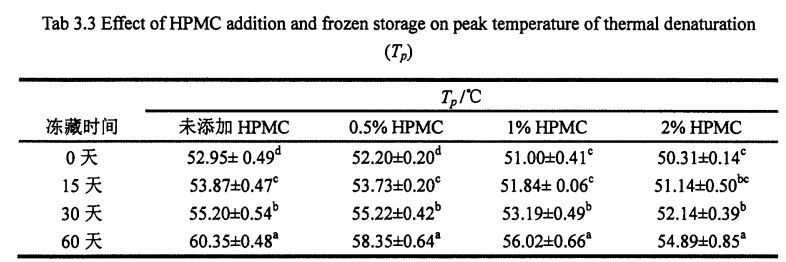
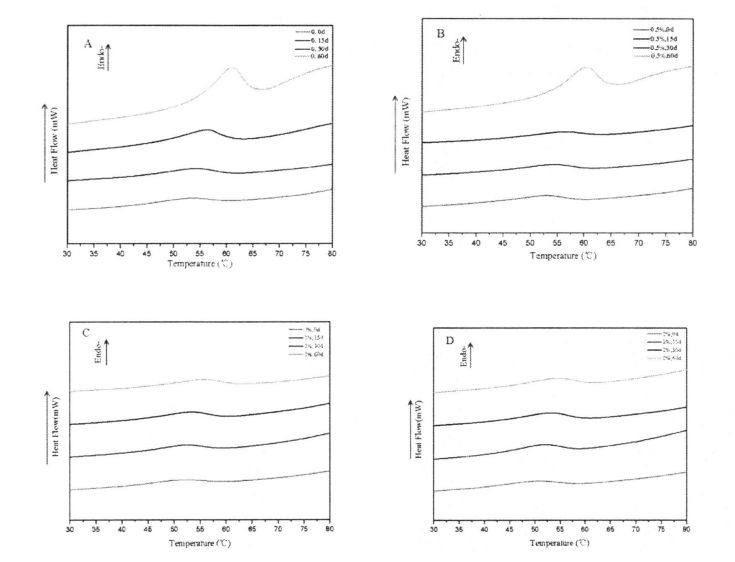
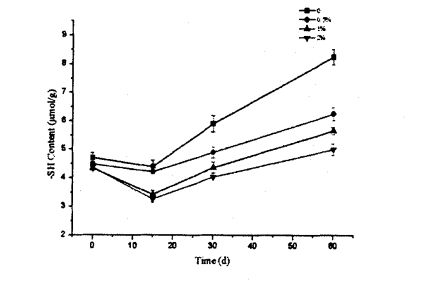
Fig 3.3 Effect of HPMC addition and frozen storage on the content of free-SH for gluten proteins As mentioned above, freezable water can form ice crystals at low temperatures and distribute in the interstices of the gluten network. Therefore, with the prolongation of freezing time, the ice crystals become larger, which squeezes the gluten protein structure more seriously, and leads to the breakage of some intermolecular and intramolecular disulfide bonds, which increases the content of free sulfhydryl groups. On the other hand, the experimental results show that HPMC can protect the disulfide bond from the extrusion damage of ice crystals, thereby inhibiting the depolymerization process of gluten protein. 3.3.4 Effects of HPMC addition amount and freezing storage time on transverse relaxation time (T2) of wet gluten mass The distribution of Transverse Relaxation Time (T2) can reflect the model and dynamic process of water migration in food materials [6]. Figure 3.4 shows the distribution of wet gluten mass at 0 and 60 days with different HPMC additions, including 4 main distribution intervals, namely 0.1.1 ms (T21), 1.10 ms (T22), 10.100 ms (dead;) and 1 00-1 000 ms (T24). Bosmans et al. (2012) found a similar distribution of wet gluten mass [1261], and they suggested that protons with relaxation times below 10 ms could be classified as rapidly relaxing protons, which are mainly derived from poor mobility the bound water, therefore, may characterize the relaxation time distribution of bound water bound to a small amount of starch, while Dang may characterize the relaxation time distribution of bound water bound to gluten protein. In addition, Kontogiorgos (2007) - t11¨, the "strands" of the gluten protein network structure are composed of several layers (Sheets) about 5 nm apart, and the water contained in these layers is limited water (or Bulk water, phase water), the mobility of this water is between the mobility of bound water and free water. A T23 možno pripísať distribúcii relaxačného času obmedzenej vody. The T24 distribution (>100 ms) has a long relaxation time, so it characterizes free water with strong mobility. This water exists in the pores of the network structure, and there is only a weak capillary force with the gluten protein system.
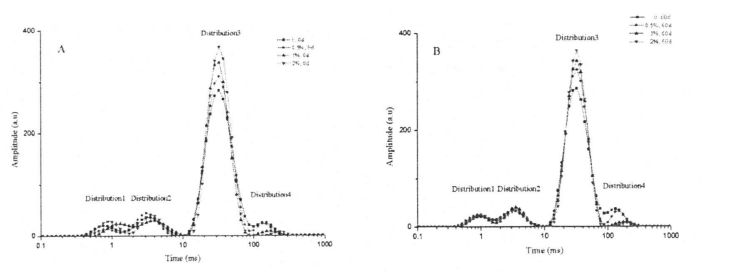
However, there were obvious differences in the height and area of T23 distribution of wet gluten mass that was not frozen and contained different HPMC additions, and with the increase of addition, the height and area of T23 distribution increased (Fig. 3.4). This change shows that HPMC can significantly increase the relative content of limited water, and it is positively correlated with the added amount within a certain range. In addition, with the extension of freezing storage time, the height and area of T23 distribution of the wet gluten mass with the same HPMC content decreased to varying degrees. Therefore, compared with bound water, limited water showed a certain effect on freezing storage. Sensitivity. This trend suggests that the interaction between the gluten protein matrix and the confined water becomes weaker. This may be because more hydrophobic groups are exposed during freezing, which is consistent with the thermal denaturation peak temperature measurements. Najmä výška a plocha distribúcie T23 pre hmotnosť vlhkého lepku s pridaním 2% HPMC nepreukázala významný rozdiel. This indicates that HPMC can limit the migration and redistribution of water, and can inhibit the transformation of the water state from the restricted state to the free state during the freezing process.

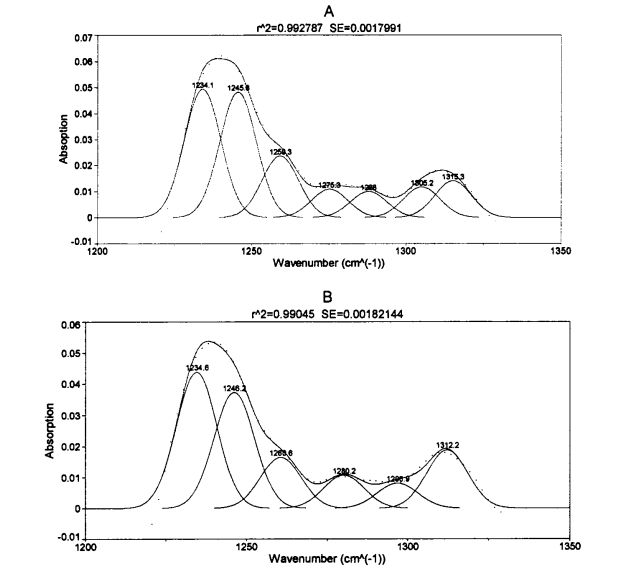
With the prolongation of frozen storage time, the secondary structure of gluten protein with different additions of HPMC changed to different degrees. It can be seen that both frozen storage and addition of HPMC have an effect on the secondary structure of gluten protein. Regardless of the amount of HPMC added, B. The folded structure is the most dominant structure, accounting for about 60%. After 60 days of frozen storage, add 0%, OB Gluten of 5% and 1% HPMC. The relative content of folds increased significantly by 3.66%, 1.87% and 1.16%, respectively, which was similar to the results determined by Meziani et al. (2011) [l33J]. Počas mrazeného skladovania však nebol významný rozdiel v mrazenom úložisku doplnkom lepku doplneného 2% HPMC. In addition, when frozen for 0 days, with the increase of HPMC addition, p. The relative content of folds increased slightly, especially when the addition amount was 2%, p. The relative content of folds increased by 2.01%. D. The folded structure can be divided into intermolecular p. Folding (caused by aggregation of protein molecules), antiparallel p. Folded and parallel p. Three substructures are folded, and it is difficult to determine which substructure occurs during the freezing process
zmenené. Some researchers believe that the increase in the relative content of the B-type structure will lead to an increase in the rigidity and hydrophobicity of the steric conformation [41], and other researchers believe that p. The increase in folded structure is due to part of the new β-Fold formation is accompanied by a weakening of the structural strength maintained by hydrogen bonding [421]. β- The increase in the folded structure indicates that the protein is polymerized through hydrophobic bonds, which is consistent with the results of the peak temperature of thermal denaturation measured by DSC and the distribution of transverse relaxation time measured by low-field nuclear magnetic resonance. Protein denaturation. On the other hand, added 0.5%, 1% and 2% HPMC gluten protein α-whirling. The relative content of helix increased by 0.95%, 4.42% and 2.03% respectively with the prolongation of freezing time, which is consistent with Wang, et a1. (2014) found similar results [134]. 0 of gluten without added HPMC. There was no significant change in the relative content of helix during the frozen storage process, but with the increase of the addition amount of freeze for 0 days. There were significant differences in the relative content of α-whirling structures.
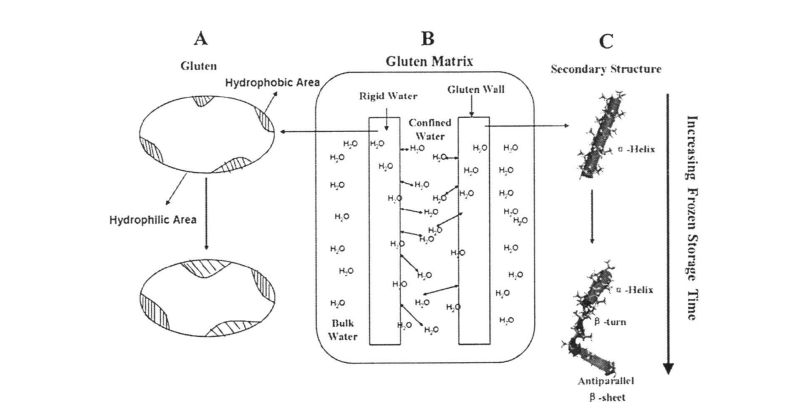
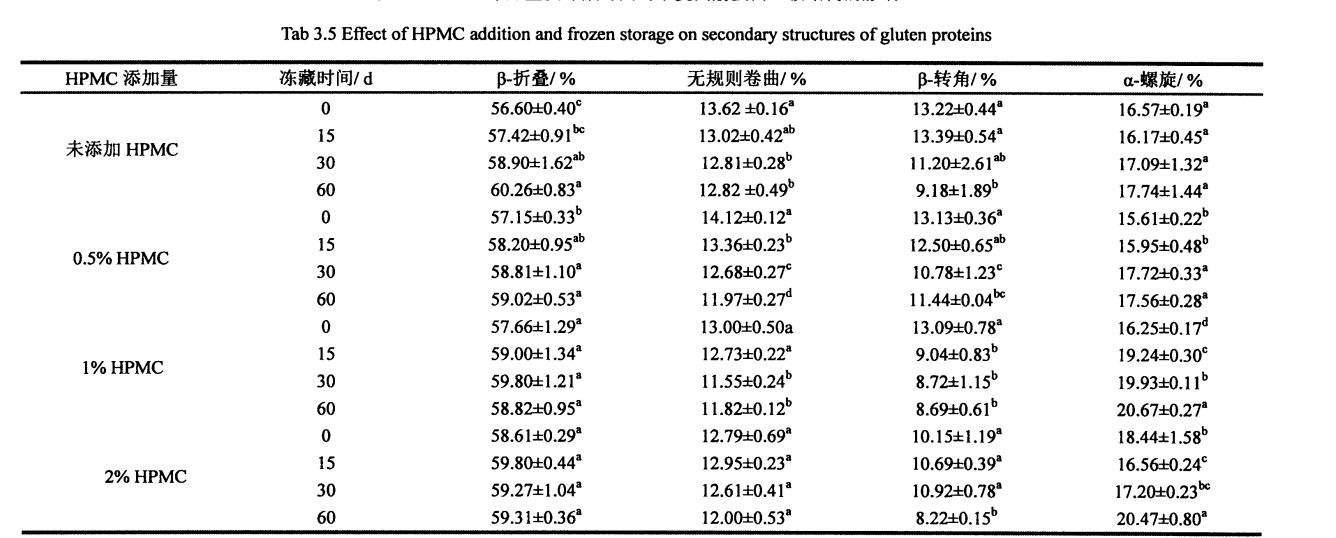
All samples with the extension of freezing time, p. The relative contents of the corners were significantly reduced. To ukazuje, že β-zákruta je veľmi citlivý na zamrznuté ošetrenie [135. 1361], and whether HPMC is added or not has no effect. Wellner, et a1. (2005) proposed that the β-chain turn of gluten protein is related to the β-turn space domain structure of the glutenin polypeptide chain [l 37]. Except that the relative content of random coil structure of gluten protein added with 2% HPMC had no significant change in frozen storage, the other samples were significantly reduced, which may be caused by the extrusion of ice crystals. In addition, when frozen for 0 days, the relative contents of α-helix, β-sheet and β-turn structure of gluten protein added with 2% HPMC were significantly different from those of gluten protein without HPMC. This may indicate that there is an interaction between HPMC and gluten protein, forming new hydrogen bonds and then affecting the conformation of the protein; or HPMC absorbs the water in the pore cavity of the protein space structure, which deforms the protein and leads to more changes between the subunits. close. The increase of the relative content of β-sheet structure and the decrease of the relative content of β-turn and α-helix structure are consistent with the above speculation. During the freezing process, the diffusion and migration of water and the formation of ice crystals destroy the hydrogen bonds that maintain the conformational stability and expose the hydrophobic groups of proteins. In addition, from the perspective of energy, the smaller the energy of the protein, the more stable it is. At low temperature, the self-organization behavior (folding and unfolding) of protein molecules proceeds spontaneously and leads to conformational changes.

Po 60 dňoch mrazeného skladovania pridajte 0%, O. Povrchová hydrofóbnosť lepku s 5%, 1%a 2%hpmc sa zvýšila o 70,53%, 55,63%, 43,97%a 36,69%(tabuľka 3.6). In particular, the surface hydrophobicity of the gluten protein without adding HPMC after being frozen for 30 days has increased significantly (P<0.05), and it is already greater than the surface of the gluten protein with 1% and 2% HPMC added after freezing for 60 days Hydrophobicity. At the same time, after 60 days of frozen storage, the surface hydrophobicity of gluten protein added with different contents showed significant differences. However, after 60 days of frozen storage, the surface hydrophobicity of gluten protein added with 2% HPMC only increased from 19.749 to 26.995, which was not significantly different from the surface hydrophobicity value after 30 days of frozen storage, and was always lower than other the value of the surface hydrophobicity of the sample. This indicates that HPMC can inhibit the denaturation of gluten protein, which is consistent with the results of DSC determination of the peak temperature of heat deformation. This is because HPMC can inhibit the destruction of protein structure by recrystallization, and due to its hydrophilicity,
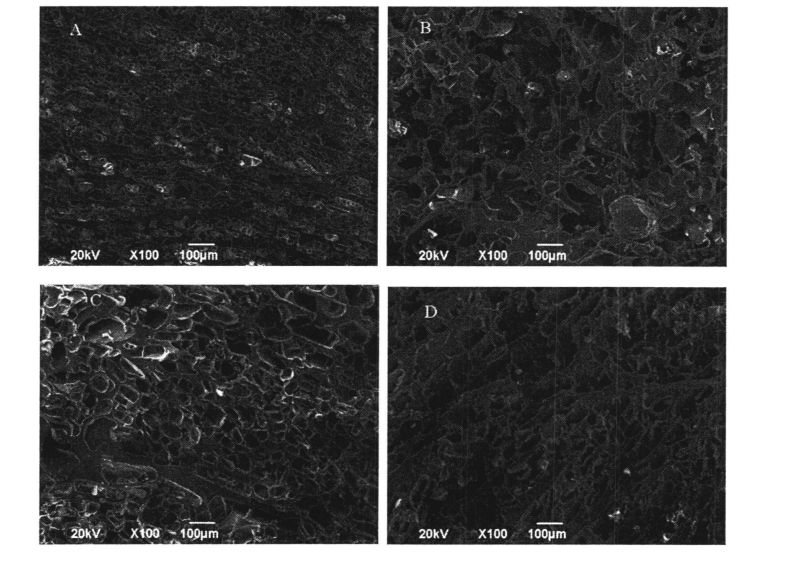
Many studies have shown that the gel strength of starch paste decreases, it is easy to age, and its quality deteriorates under the condition of freezing storage, such as Canet, et a1. (2005) studied the effect of freezing temperature on the quality of potato starch puree; Ferrero, et a1. (1993) investigated the effects of freezing rate and different types of additives on the properties of wheat and corn starch pastes [151-156]. However, there are relatively few reports on the effect of frozen storage on the structure and properties of starch granules (native starch), which needs to be further explored. Frozen dough (excluding pre-cooked frozen dough) is in the form of ungelatinized granules under the condition of frozen storage. Therefore, studying the structure and structural changes of native starch by adding HPMC has a certain effect on improving the processing properties of frozen dough. significance.
Výrobca
Po zodpovedajúcom čase ošetrenia zamrznutia boli vzorky odobraté, úplne rozmrazené a sušené v peci pri 40 ° C počas 48 hodín. Nakoniec to bolo uzemnené cez 100-meshový sito, aby sa získala vzorka s tuhým práškom na použitie (vhodná na testovanie XRD). Pozri Xie, et a1. (2014) Metóda prípravy vzorky a stanovenie termodynamických vlastností 1611, vážte 10 mg vzorky škrobu do tekutého hliníkového téglika s ultramikro analytickou rovnováhou, pridajte 20 mg ditilovanej vody v pomere 1: 2, tlačí a utesnite a umiestnite ho do 4 ° C v chladničke, rovnováhy po dobu 24 hodín. Zmrazte pri 18 ° C (0, 15, 30 a 60 dní). Add 0.5%, 1%, 2% (w/w) HPMC to replace the corresponding quality of starch, and other preparation methods remain unchanged. After the freezing storage time is over, take out the crucible and equilibrate at 4 °C for 4 h.





However, with the prolongation of freezing storage time, the values of K and n increased to different degrees, among which the value of K increased from 78.240 ± 1.661 Pa·sn (unadded, 0 days) to 95.570 ± 1, respectively. 2.421 Pa·sn (no addition, 60 days), increased from 65.683±1.035 Pa ·S n (addition of O. 5% HPMC, 0 days) to 51.384±1.350 Pa ·S n (Add to 0.5% HPMC, 60 days), increased from 43.122±1.047 Pa ·sn (adding 1% HPMC, 0 days) to 56.538±1.378 Pa ·sn (adding 1% HPMC, 60 days) ), and increased from 13.926 ± 0.330 Pa ·sn (adding 2% HPMC, 0 days) to 16.064 ± 0.465 Pa ·sn (adding 2% HPMC, 60 days); 0.277 ± 0.011 (without adding HPMC, 0 days) rose to O. 334±0.014 (no addition, 60 days), increased from 0.310±0.009 (0.5% HPMC added, 0 day) to 0.336±0.014 (0.5% HPMC added, 60 days), from 0.323 ± 0.013 (add 1% HPMC, 0 days) to 0.340 ± 0.013 (add 1% HPMC, 60 days), and from 0.431 ± 0.013 (add 1% HPMC, 60 days) 2% HPMC, 0 days) to 0.404+0.020 (add 2% HPMC, 60 days). By comparison, it can be found that with the increase of the addition amount of HPMC, the change rate of K and Knife value decreases successively, which shows that the addition of HPMC can make the starch paste stable under the action of shearing force, which is consistent with the measurement results of starch gelatinization characteristics. dôsledné.
4.3.4 Účinky množstva pridávania HPMC a doby mrazeného skladovania na dynamickú viskoelasticitu škrobovej pasty

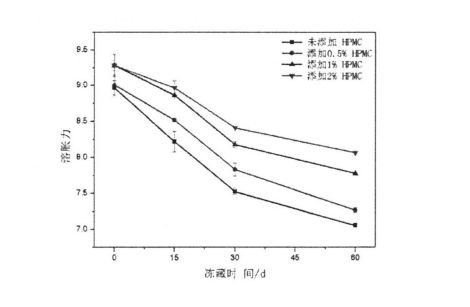
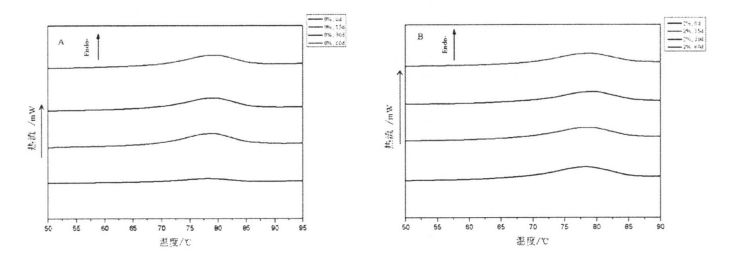
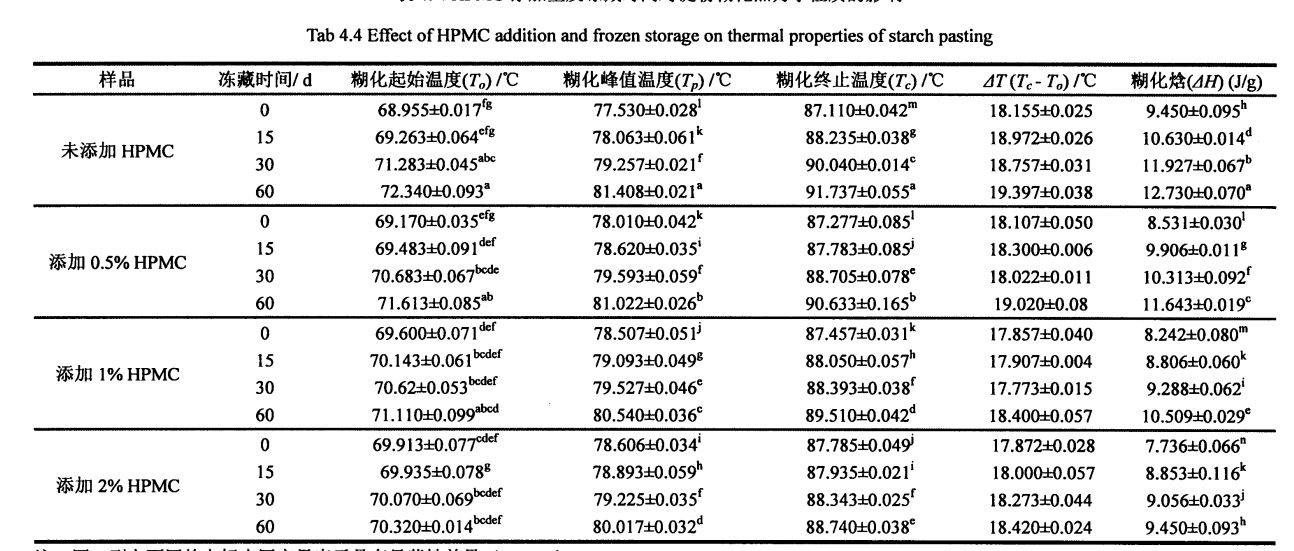
On the other hand, starch gelatinization To, T p, Tc, △T and △Hall increased with the extension of freezing time. Specifically, starch gelatinization with 1% or 2% HPMC added had no significant difference after freezing for 60 days, while starch without or with 0.5% HPMC was added from 68.955±0.01 7 (frozen storage for 0 days) increased to 72.340 ± 0.093 (frozen storage for 60 days), and from 69.170 ± 0.035 (frozen storage for 0 days) to 71.613 ± 0.085 (frozen storage for 0 days) 60 days); after 60 days of frozen storage, the growth rate of starch gelatinization decreased with the increase of HPMC addition, such as starch without HPMC added from 77.530 ± 0.028 (frozen storage for 0 days) to 81.028. 408 ± 0.021 (frozen storage for 60 days), while the starch added with 2% HPMC increased from 78.606 ± 0.034 (frozen storage for 0 days) to 80.017 ± 0.032 (frozen storage for 60 days). days); in addition, ΔH also showed the same change rule, which increased from 9.450 ± 0.095 (no addition, 0 days) to 12.730 ± 0.070 (no addition, 60 days), respectively, from 8.450 ± 0.095 (no addition, 0 days) to 12.730 ± 0.070 (no addition, 60 days), respectively. 531 ± 0.030 (add 0.5%, 0 days) to 11.643 ± 0.019 (add 0.5%, 60 days), from 8.242 ± 0.080 (add 1%, 0 days) to 10.509 ± 0.029 (add 1%, 60 days), and from 7.736 ± O. 066 (2% addition, 0 days) rose to 9.450 ± 0.093 (2% addition, 60 dni). The main reasons for the above-mentioned changes in the thermodynamic properties of starch gelatinization during the frozen storage process are the formation of damaged starch, which destroys the amorphous region (amorphous region) and increases the crystallinity of the crystalline region. The coexistence of the two increases the relative crystallinity of starch, which in turn leads to an increase in thermodynamic indexes such as starch gelatinization peak temperature and gelatinization enthalpy. However, through comparison, it can be found that under the same freezing storage time, with the increase of HPMC addition, the increase of starch gelatinization To, T p, Tc, ΔT and ΔH gradually decreases. It can be seen that the addition of HPMC can effectively maintain the relative stability of the starch crystal structure, thereby inhibiting the increase of the thermodynamic properties of starch gelatinization.
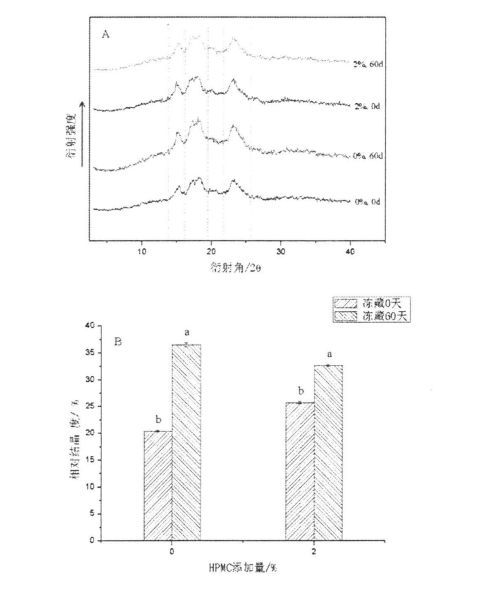
Materiál a nástroje
Výrobca
Shanghai Spectrum Scientific Instrument Co., Ltd.

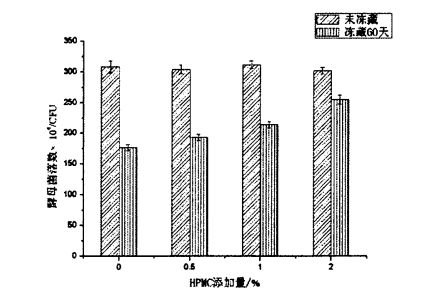
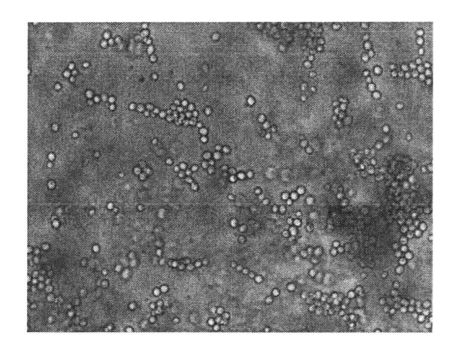
Glutathione is a tripeptide compound composed of glutamic acid, cysteine and glycine, and has two types: reduced and oxidized. When the yeast cell structure is destroyed and died, the permeability of the cells increases, and the intracellular glutathione is released to the outside of the cell, and it is reductive. Obzvlášť stojí za zmienku, že znížený glutatión zníži disulfidové väzby (-SS-) vytvorené zosieťovaním gluténových proteínov, čím ich prelomí, aby vytvorili voľné sulfhydrylové skupiny (.SH), ktoré zase ovplyvňujú štruktúru siete cesta. stability and integrity, and ultimately lead to the deterioration of the quality of fermented flour products. Zvyčajne pri prostredí environmentálneho stresu (ako je nízka teplota, vysoká teplota, vysoký osmotický tlak atď.) Kvasinky znížia svoju vlastnú metabolickú aktivitu a zvýši jej odolnosť proti stresu alebo sa súčasne produkuje spóry. When the environmental conditions are suitable for its growth and reproduction again, then restore the metabolism and proliferation vitality. Niektoré kvasinky so zlou stresovou rezistenciou alebo silnou metabolickou aktivitou však stále zomrú, ak sa na dlhú dobu uchovávajú v zmrazenom skladovacom prostredí.
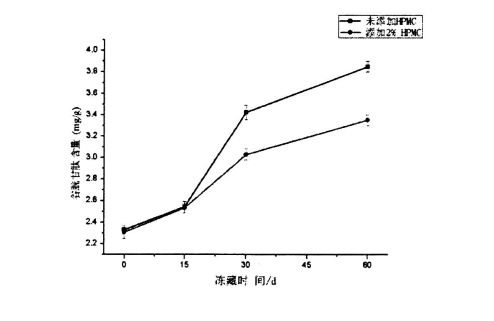
Čas príspevku: október-08-2022







